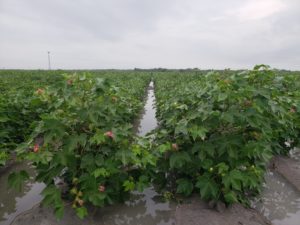by Josh McGinty and Gaylon Morgan, Texas A&M AgriLife Extension Service
The 2018 season in South Texas has been a tough one. In southernmost areas, a dry winter and spring meant planting moisture was scarce, while excessive rainfall was a common problem that delayed field preparation and planting in the Upper Gulf Coast. Since planting, excessive heat, wind, and very limited rainfall has been a common occurrence across South Texas, leading to severe moisture stress and early cutout (5 nodes above white flower) in many fields. Then on June 19-20, widespread and heavy rainfall (6-10 inches) occurred across South Texas. With excessive soil moisture in the fields, the question now is whether or not our cotton crop will benefit from this late moisture and what should be done to manage this crop?
Bear in mind that cotton is a perennial plant that will resume growth and likely attempt to put on additional fruit. On the surface, this may sound like a good thing; however, we must consider whether or not it will be worth it to wait and manage for these later developing bolls. Today’s squares won’t become mature bolls for at least 70 days, and in many regions (especially those along the coast) waiting to harvest these bolls will place growers at greater risk of losing yield and lint quality due to tropical weather in August and September.
With the difficulties at harvest in the Upper Gulf Coast due to rain in 2016 and the disaster that was Hurricane Harvey still fresh in our memory, it is advisable to continue to manage the crop we have for a timely harvest in late July to August. Careful monitoring of plant growth and judicious use of plant growth regulators after these rains will be critical for keeping these plants at a manageable size for an efficient harvest. Some of the later planted or replanted cotton, especially up the coast, may be young enough to benefit from these rains, but we still need to be mindful of the increasing threat of tropical weather as we get further into the summer and early fall.

Josh McGinty
Assistant Professor & Extension Agronomist
Corpus Christi, TX
jmcginty@tamu.edu
